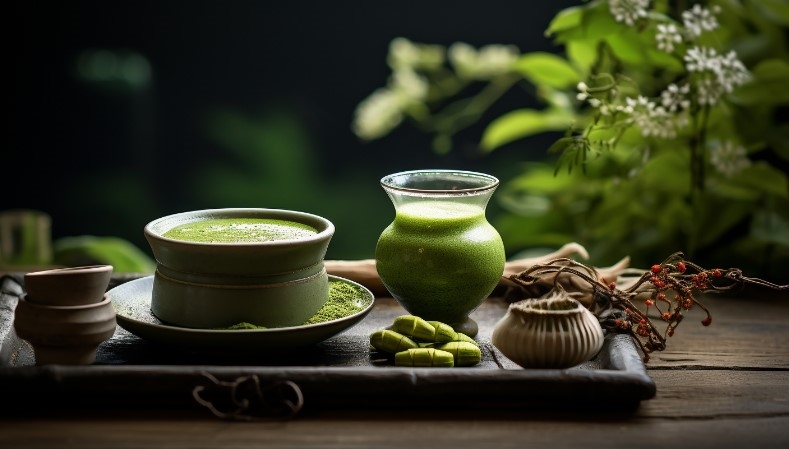Der Weg des Matcha

Die Beziehung zwischen Matcha und Japan, wie Uhren zur Schweiz, Parfüm zu Frankreich, zwar nicht "eng", aber immer eng verbunden.
Heute ist japanischer Matcha längst zum wichtigsten Symbol und Träger der japanischen Teekultur geworden und wird von immer mehr Verbrauchern geschätzt und anerkannt.
Weitergeben
Im Volksmund heißt es, Matcha ist ein pulverförmiges Teeprodukt, das nach einer speziellen Verarbeitung aus Teeblättern entsteht. Dies ist auch der Grund, warum Matcha in den frühen Jahren in der chinesischen Schrift als "letzter Tee" geschrieben wurde, wobei "letzter" "Pulver" und "gebrochenes Pulver" bedeutet.
Der Aufstieg des Teetrinkens in Japan ist nicht ohne Schwierigkeiten verlaufen.
Japanischen historischen Aufzeichnungen zufolge brachte der japanische Mönch Yuki bereits in der Nara-Zeit chinesische Teebäume mit nach Japan. Aber der Teeanbau setzte sich zu dieser Zeit nicht wirklich durch.
In der Nara- und Heian-Zeit hatte die japanische Teekultur noch keine eigenen Merkmale entwickelt, sondern war nur eine vorläufige Studie und Kopie der chinesischen Teekultur. Bei den Adligen, Mönchen und der Oberschicht der Riwiting-Dynastie ähnelt der Teeanbau, die Teezubereitung und das Teetrinken in jeder Phase der Tang-Dynastie, und der Geschmack der Nachahmung ist sehr stark.
Während der Kamakura-Periode begann die japanische Teekultur, sich mit der lokalen Religion, Philosophie, Ästhetik usw. zu verbinden und einen japanischen Stil namens "Teesuppe" zu entwickeln. Auch die Verwendung von Matcha-Tee ist zu einem wichtigen Bestandteil der japanischen Teekultur geworden.
Interessanterweise begann sich in der Muromachi-Ära der Stil des Teetrinkens in Japan zu ändern. Zu dieser Zeit war China in die Ming-Dynastie eingetreten, aber Japan, jenseits des Meeres, sehnte sich plötzlich nach der Teekunst der chinesischen Song-Dynastie und ahmte den Wind des "Kampftees" in der Song-Dynastie nach und formte seine eigene "Kampfteekunst".
In der frühen Muromachi-Periode wurde der luxuriöse "Teekampf" zum Mainstream. Im Gegensatz zum eleganten "Teekampf" der Song-Dynastie bestand der Zweck des "Teekampfes" der japanischen Samurai-Klasse darin, soziale Kontakte zu pflegen, Reichtum zur Schau zu stellen und natürlich zu essen und zu trinken. Es mag daran liegen, dass der "Kampftee" nicht wirklich elegant ist, dass der luxuriöse "Kampftee" aufblühte und wieder verschwand, und dass die Teekultur der Dongshan-Akademie zu wachsen begann.
Die Higashiyama-Kultur, die in der Mitte der Muromachi-Periode sehr populär war, hat eine starke buchhafte Atmosphäre. Zu dieser Zeit verband die Tee-Akademie unter der Leitung des Zen-Meisters Murata die fremde chinesische Kultur mit der japanischen, wodurch die "Teesuppe" technischer wurde und auch die japanische Teezeremonie Gestalt annahm. Aus diesem Grund nimmt die Higashiyama-Periode oder Higashiyama-Kultur eine sehr wichtige Stellung in der Geschichte der japanischen Teezeremonie ein.
Nach der frühen Nara- und Heian-Epoche, der mittleren Kamakura- und Muromachi-Epoche, der späten Edo-Epoche und der modernen Ära ist die japanische Teekultur schließlich gereift.
Zufahrtsstraße
Im Zuge der Lokalisierung der Teekultur und des Auftauchens verschiedener Meister sind die Merkmale der japanischen Teezeremonie fein, exquisit und wunderbar geworden.
Verbesserung der Qualität
Während der Muromachi-Ära erfanden die Teebauern von Uji speziell für die örtlichen Boden- und Klimaverhältnisse die "Mulch-Anbaumethode", d. h. die Teebäume werden vor der Ernte "abgedeckt", um den Matcha grüner und süßer zu machen, und auch der Matcha aus Uji ist berühmt.
Verbessern Sie den Prozess
Für die Japaner jener Zeit war Tee eher ein Handwerk als ein Getränk. Das spiegelt sich auch im Prozess der Teezubereitung wider, der aus strengen Schritten und ausgefeilten Verfahren besteht. Von der Beschattung vor dem Pflücken, dem Dampfabtöten nach dem Pflücken, dem Backen im Ofen bis hin zum Schneiden und Zerkleinern sind mehr als ein Dutzend Prozesse exquisit, und selbst die Steinmühle, die für die Feinmahlung verwendet wird, ist das Streben nach Natürlichkeit.
Reformtee-Stil
In der Teekultur der Dongshan-Akademie ist der Künstler Neng Ami ein wichtiger Vertreter. Er wurde als Krieger geboren und ist in der Schriftstellerei, der Malerei und der Teekultur sehr bewandert. Unter seiner Schirmherrschaft fegte die japanische Teeparty den extravaganten und lärmenden Wind weg und begann, einen neuen Teestil der "Akademiedekoration" und "Tischdekoration" zu formen.
Gestaltung einer Teezeremonie
Auf Nois Empfehlung hin wurde Murata in seinen späteren Jahren Teezeremonie-Lehrer des Shoguns Yoshimasa Ashikaga. Nachdem er die Teekultur der Dongshan-Akademie voll und ganz verstanden hatte und mit einer großen Anzahl von Kultur- und Kunstschätzen in Berührung gekommen war, die der General gesammelt hatte, machte Murata Pearls Teezeremoniegedanke einen weiteren Sprung. Er kombinierte den "Soan-Tee" der Nara Ryu aus der einfachen Klasse mit dem "Akademie-Tee" aus der edlen Klasse und vollzog damit einen wichtigen Schritt von der Teekultur zur Teezeremonie. Murata Pearl wird auch als "der Urvater der japanischen Teezeremonie" bezeichnet.
Zu diesem Zeitpunkt waren die drei für die Entstehung der Teezeremonie notwendigen Schritte - der Volkstee, die Verbindung von Tee und Zen sowie die Integration von edlem Tee und Volkstee - abgeschlossen. Nachdem sie jahrelang den chinesischen Brauch des Teetrinkens akzeptiert hatten, entwickelten die Japaner schließlich ihre eigene Teezeremonie.
Matcha-Lieferant: www.backvita.com
E-Mail: [email protected]
Telefon: +86 (029) 8187 2325
